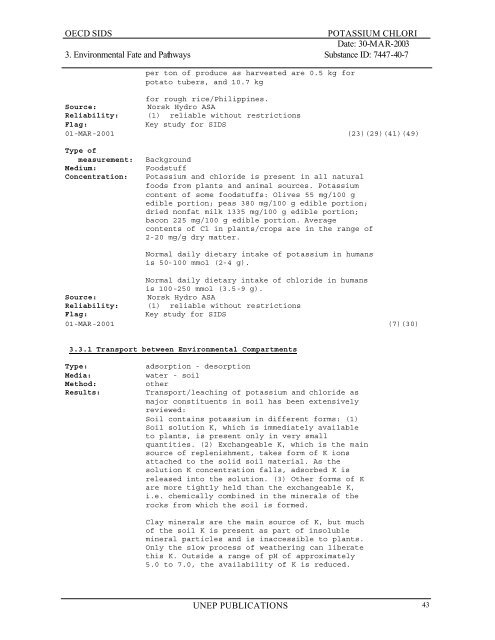POTASSIUM CHLORIDE CAS N°: 7447-40-7
POTASSIUM CHLORIDE CAS N°: 7447-40-7
POTASSIUM CHLORIDE CAS N°: 7447-40-7
You also want an ePaper? Increase the reach of your titles
YUMPU automatically turns print PDFs into web optimized ePapers that Google loves.
OECD SIDS <strong>POTASSIUM</strong> CHLORI<br />
Date: 30-MAR-2003<br />
3. Environmental Fate and Pathways Substance ID: <strong>7447</strong>-<strong>40</strong>-7<br />
per ton of produce as harvested are 0.5 kg for<br />
potato tubers, and 10.7 kg<br />
for rough rice/Philippines.<br />
Source:<br />
Norsk Hydro ASA<br />
Reliability: (1) reliable without restrictions<br />
Flag:<br />
Key study for SIDS<br />
01-MAR-2001 (23)(29)(41)(49)<br />
Type of<br />
measurement:<br />
Medium:<br />
Concentration:<br />
Background<br />
Foodstuff<br />
Potassium and chloride is present in all natural<br />
foods from plants and animal sources. Potassium<br />
content of some foodstuffs: Olives 55 mg/100 g<br />
edible portion; peas 380 mg/100 g edible portion;<br />
dried nonfat milk 1335 mg/100 g edible portion;<br />
bacon 225 mg/100 g edible portion. Average<br />
contents of Cl in plants/crops are in the range of<br />
2-20 mg/g dry matter.<br />
Normal daily dietary intake of potassium in humans<br />
is 50-100 mmol (2-4 g).<br />
Normal daily dietary intake of chloride in humans<br />
is 100-250 mmol (3.5-9 g).<br />
Source:<br />
Norsk Hydro ASA<br />
Reliability: (1) reliable without restrictions<br />
Flag:<br />
Key study for SIDS<br />
01-MAR-2001 (7)(30)<br />
3.3.1 Transport between Environmental Compartments<br />
Type:<br />
Media:<br />
Method:<br />
Results:<br />
adsorption - desorption<br />
water - soil<br />
other<br />
Transport/leaching of potassium and chloride as<br />
major constituents in soil has been extensively<br />
reviewed:<br />
Soil contains potassium in different forms: (1)<br />
Soil solution K, which is immediately available<br />
to plants, is present only in very small<br />
quantities. (2) Exchangeable K, which is the main<br />
source of replenishment, takes form of K ions<br />
attached to the solid soil material. As the<br />
solution K concentration falls, adsorbed K is<br />
released into the solution. (3) Other forms of K<br />
are more tightly held than the exchangeable K,<br />
i.e. chemically combined in the minerals of the<br />
rocks from which the soil is formed.<br />
Clay minerals are the main source of K, but much<br />
of the soil K is present as part of insoluble<br />
mineral particles and is inaccessible to plants.<br />
Only the slow process of weathering can liberate<br />
this K. Outside a range of pH of approximately<br />
5.0 to 7.0, the availability of K is reduced.<br />
UNEP PUBLICATIONS 43
















